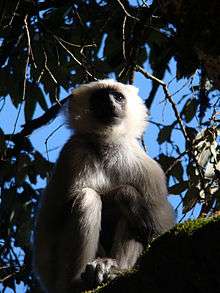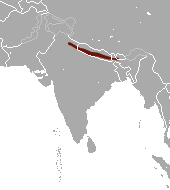Tarai gray langur
The Tarai gray langur (Semnopithecus hector) is an Old World monkey, and was formerly considered a subspecies of the northern plains gray langur. The species is listed as Near Threatened, as there are probably not many more than 10,000 mature individuals, and it is experiencing a continuing decline.[1]
| Tarai gray langur | |
|---|---|
 | |
| Tarai Gray langur at Kilbury Road Nainital | |
| Scientific classification | |
| Kingdom: | Animalia |
| Phylum: | Chordata |
| Class: | Mammalia |
| Order: | Primates |
| Suborder: | Haplorhini |
| Infraorder: | Simiiformes |
| Family: | Cercopithecidae |
| Genus: | Semnopithecus |
| Species: | S. hector[2] |
| Binomial name | |
| Semnopithecus hector[2] Pocock, 1928 | |
 | |
| Tarai gray langur range | |
It is one of several Semnopithecus species named after characters from The Iliad, along with Semnopithecus ajax and Semnopithecus priam.
Distribution and habitat
The Tarai gray langur is native to northern India, Bhutan, and Nepal, and inhabits the Himalayan foothills from Rajaji National Park to southwestern Bhutan. It also lives in the moist deciduous forest of the Siwalik Hills to oak forest ranging from altitudes of 150 to 1,600 m (490 to 5,250 ft).[1]
Ecology and behaviour
Tarai gray langurs are arboreal, mainly terrestrial, diurnal, folivorous, and occur in multi-male multi-female groups.[3] They have been observed feeding in orchards and crop fields outside of Rajaji National Park.[1]
References
- Molur, S. & Chhangani, A. (2008). "Semnopithecus hector". IUCN Red List of Threatened Species. 2008: e.T39837A10274974.
- Groves, C. P. (2005). Wilson, D. E.; Reeder, D. M. (eds.). Mammal Species of the World: A Taxonomic and Geographic Reference (3rd ed.). Baltimore: Johns Hopkins University Press. p. 174. ISBN 0-801-88221-4. OCLC 62265494.
- Molur, S., Brandon-Jones, D., Dittus, W., Eudey, A., Kumar, A., Singh, M., Feeroz, M. M., Chalise, M., Priya, P. and Walker, S. (2003) Status of South Asian Primates: Conservation Assessment and Management Plan Workshop Report, 2003. Zoo Outreach Organization/CBSG-South Asia, Coimbatore, India.
